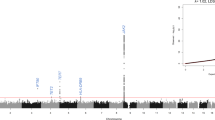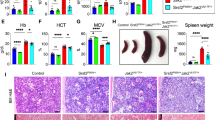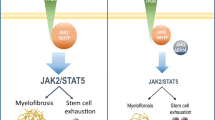Abstract
In addition to high-molecular risk (HMR) mutations (ASXL1, EZH2, SRSF2, IDH, and U2AF1Q157), lower JAK2V617F variant allele frequencies (VAF) have been demonstrated to be associated with poor prognosis of myelofibrosis (MF) patients. Nevertheless, the relationship between JAK2V617F VAF and HMR mutations remains inconclusive. To address this, we analyzed the mutation status of 54 myeloid neoplasm-relevant genes using targeted next-generation sequencing in 124 MF patients. Three cohorts from multiple international centers were analyzed for external validation. Among JAK2-mutated patients, the presence of HMR mutations drove poor prognosis in patients with lower JAK2V617F VAF but not in those with higher JAK2V617F VAF. Survival analyses showed consistent results across validation cohorts. In multivariable analysis, concurrent HMR and a lower JAK2V617F VAF was identified as an independent adverse prognostic factor for survival, irrespective of age, MIPSS70, MIPSS70 + v2, and GIPSS risk groups. Mutation co-occurrence tests revealed no shared mutational pattern over different cohorts, excluding potential confounding effect from other concurrent mutations. Importantly, the integration of HMR/JAK2V617F VAF (≤50%) status significantly enhanced existing prognostic models, as evidenced by higher c-indexes and time-dependent ROC analyses. Single-cell studies with sequential follow-ups are warranted to decipher the clonal evolution of MF and how it relates to JAK2V617F VAF dynamics.
This is a preview of subscription content, access via your institution
Access options
Subscribe to this journal
Receive 12 print issues and online access
$259.00 per year
only $21.58 per issue
Buy this article
- Purchase on SpringerLink
- Instant access to full article PDF
Prices may be subject to local taxes which are calculated during checkout






Similar content being viewed by others
Data availability
Requests for additional information not provided in the main text or Supplementary Material should be sent to the corresponding authors. The data are not publicly available due to privacy and ethical restrictions.
References
Khoury JD, Solary E, Abla O, Akkari Y, Alaggio R, Apperley JF, et al. The 5th edition of the World Health Organization Classification of haematolymphoid tumours: myeloid and histiocytic/dendritic neoplasms. Leukemia. 2022;36:1703–19.
Arber DA, Orazi A, Hasserjian RP, Borowitz MJ, Calvo KR, Kvasnicka H-M, et al. International Consensus Classification of myeloid neoplasms and acute leukemias: integrating morphologic, clinical, and genomic data. Blood. 2022;140:1200–28.
Tefferi A. Primary myelofibrosis: 2023 update on diagnosis, risk-stratification, and management. Am J Hematol. 2023;98:801–21.
Vannucchi AM, Lasho TL, Guglielmelli P, Biamonte F, Pardanani A, Pereira A, et al. Mutations and prognosis in primary myelofibrosis. Leukemia. 2013;27:1861–9.
Rumi E, Pietra D, Pascutto C, Guglielmelli P, Martínez-Trillos A, Casetti I, et al. Clinical effect of driver mutations of JAK2, CALR, or MPL in primary myelofibrosis. Blood. 2014;124:1062–9.
Tefferi A, Nicolosi M, Mudireddy M, Szuber N, Finke CM, Lasho TL, et al. Driver mutations and prognosis in primary myelofibrosis: Mayo-Careggi MPN alliance study of 1095 patients. Am J Hematol. 2018;93:348–55.
Passamonti F, Mora B. Myelofibrosis. Blood. 2023;141:1954–70.
Cervantes F, Dupriez B, Pereira A, Passamonti F, Reilly JT, Morra E, et al. New prognostic scoring system for primary myelofibrosis based on a study of the International Working Group for Myelofibrosis Research and Treatment. Blood. 2009;113:2895–901.
Passamonti F, Cervantes F, Vannucchi AM, Morra E, Rumi E, Pereira A, et al. A dynamic prognostic model to predict survival in primary myelofibrosis: a study by the IWG-MRT (International Working Group for Myeloproliferative Neoplasms Research and Treatment). Blood. 2010;115:1703–8.
Gangat N, Caramazza D, Vaidya R, George G, Begna K, Schwager S, et al. DIPSS plus: a refined Dynamic International Prognostic Scoring System for primary myelofibrosis that incorporates prognostic information from karyotype, platelet count, and transfusion status. J Clin Oncol. 2011;29:392–7.
Guglielmelli P, Lasho TL, Rotunno G, Mudireddy M, Mannarelli C, Nicolosi M, et al. MIPSS70: mutation-enhanced international prognostic score system for transplantation-age patients with primary myelofibrosis. J Clin Oncol. 2018;36:310–8.
Tefferi A, Guglielmelli P, Lasho TL, Gangat N, Ketterling RP, Pardanani A, et al. MIPSS70+ version 2.0: mutation and karyotype-enhanced international prognostic scoring system for primary myelofibrosis. J Clin Oncol. 2018;36:1769–70.
Tefferi A, Guglielmelli P, Nicolosi M, Mannelli F, Mudireddy M, Bartalucci N, et al. GIPSS: genetically inspired prognostic scoring system for primary myelofibrosis. Leukemia. 2018;32:1631–42.
Guglielmelli P, Lasho TL, Rotunno G, Score J, Mannarelli C, Pancrazzi A, et al. The number of prognostically detrimental mutations and prognosis in primary myelofibrosis: an international study of 797 patients. Leukemia. 2014;28:1804–10.
Tefferi A, Lasho TL, Finke CM, Elala Y, Hanson CA, Ketterling RP, et al. Targeted deep sequencing in primary myelofibrosis. Blood Adv. 2016;1:105–11.
Tefferi A, Finke CM, Lasho TL, Hanson CA, Ketterling RP, Gangat N, et al. U2AF1 mutation types in primary myelofibrosis: phenotypic and prognostic distinctions. Leukemia. 2018;32:2274–8.
Luque Paz D, Riou J, Verger E, Cassinat B, Chauveau A, Ianotto J-C, et al. Genomic analysis of primary and secondary myelofibrosis redefines the prognostic impact of ASXL1 mutations: a FIM study. Blood Adv. 2021;5:1442–51.
Guglielmelli P, Coltro G, Mannelli F, Rotunno G, Loscocco GG, Mannarelli C, et al. ASXL1 mutations are prognostically significant in PMF, but not MF following essential thrombocythemia or polycythemia vera. Blood Adv. 2022;6:2927–31.
Tefferi A, Lasho TL, Huang J, Finke C, Mesa RA, Li CY, et al. Low JAK2V617F allele burden in primary myelofibrosis, compared to either a higher allele burden or unmutated status, is associated with inferior overall and leukemia-free survival. Leukemia. 2008;22:756–61.
Guglielmelli P, Barosi G, Specchia G, Rambaldi A, Lo Coco F, Antonioli E, et al. Identification of patients with poorer survival in primary myelofibrosis based on the burden of JAK2V617F mutated allele. Blood. 2009;114:1477–83.
Vannucchi AM, Pieri L, Guglielmelli P. JAK2 allele burden in the myeloproliferative neoplasms: effects on phenotype, prognosis and change with treatment. Ther Adv Hematol. 2011;2:21–32.
Wang YH, Lin CC, Lee SH, Tsai CH, Wu SJ, Hou HA, et al. ASXL1 mutation confers poor prognosis in primary myelofibrosis patients with low JAK2V617F allele burden but not in those with high allele burden. Blood Cancer J. 2020;10:99.
Wiseman DH, Williams EL, Wilks DP, Sun Leong H, Somerville TDD, Dennis MW, et al. Frequent reconstitution of IDH2R140Q mutant clonal multilineage hematopoiesis following chemotherapy for acute myeloid leukemia. Leukemia. 2016;30:1946–50.
Kröger N, Wolschke C, Gagelmann N. How I treat transplant-eligible patients with myelofibrosis. Blood. 2023;142:1683–96.
Barosi G, Poletto V, Massa M, Campanelli R, Villani L, Bonetti E, et al. JAK2 V617F genotype is a strong determinant of blast transformation in primary myelofibrosis. PLoS ONE. 2013;8:e59791.
Kishtagari A, Khan MAW, Li Y, Vlasschaert C, Marneni N, Silver AJ, et al. Driver mutation zygosity is a critical factor in predicting clonal hematopoiesis transformation risk. Blood Cancer J. 2024;14:6.
Sallman DA, Padron E. Integrating mutation variant allele frequency into clinical practice in myeloid malignancies. Hematol Oncol Stem Cell Ther. 2016;9:89–95.
Beer PA, Delhommeau F, LeCouédic JP, Dawson MA, Chen E, Bareford D, et al. Two routes to leukemic transformation after a JAK2 mutation-positive myeloproliferative neoplasm. Blood. 2010;115:2891–900.
Maslah N, Benajiba L, Giraudier S, Kiladjian J-J, Cassinat B. Clonal architecture evolution in myeloproliferative neoplasms: from a driver mutation to a complex heterogeneous mutational and phenotypic landscape. Leukemia. 2023;37:957–63.
Grinfeld J, Nangalia J, Baxter EJ, Wedge DC, Angelopoulos N, Cantrill R, et al. Classification and personalized prognosis in myeloproliferative neoplasms. N Engl J Med. 2018;379:1416–30.
Miles LA, Bowman RL, Merlinsky TR, Csete IS, Ooi AT, Durruthy-Durruthy R, et al. Single-cell mutation analysis of clonal evolution in myeloid malignancies. Nature. 2020;587:477–82.
Calabresi L, Carretta C, Romagnoli S, Rotunno G, Parenti S, Bertesi M, et al. Clonal dynamics and copy number variants by single-cell analysis in leukemic evolution of myeloproliferative neoplasms. Am J Hematol. 2023;98:1520–31.
Zhao L-P, Cazaux M, Maslah N, Daltro De Oliveira R, Verger E, Soret-Dulphy J, et al. Myeloproliferative neoplasms (MPN) clonal evolution landscape and its impact on patients’ prognosis. Blood. 2021;138:317.
Luque Paz D, Bader MS, Nienhold R, Rai S, Almeida Fonseca T, Stetka J, et al. Impact of clonal architecture on clinical course and prognosis in patients with myeloproliferative neoplasms. Hemasphere. 2023;7:e885.
Williams N, Lee J, Mitchell E, Moore L, Baxter EJ, Hewinson J, et al. Life histories of myeloproliferative neoplasms inferred from phylogenies. Nature. 2022;602:162–8.
Harrison CN, Vannucchi AM, Kiladjian JJ, Al-Ali HK, Gisslinger H, Knoops L, et al. Long-term findings from COMFORT-II, a phase 3 study of ruxolitinib vs best available therapy for myelofibrosis. Leukemia. 2016;30:1701–7.
Kiladjian J-J, Ianotto J-C, Soret J, Maslah N, Chaffaut C, Boyer perrard F, et al. Final results of Ruxopeg, a phase 1/2 adaptive randomized trial of ruxolitinib (Rux) and pegylated interferon alpha (IFNa) 2a in patients with myelofibrosis (MF). Blood. 2022;140:577–8.
Pemmaraju N, Garcia JS, Potluri J, Harb JG, Sun Y, Jung P, et al. Addition of navitoclax to ongoing ruxolitinib treatment in patients with myelofibrosis (REFINE): a post-hoc analysis of molecular biomarkers in a phase 2 study. Lancet Haematol. 2022;9:e434–e44.
Chifotides HT, Verstovsek S, Bose P. Association of myelofibrosis phenotypes with clinical manifestations, molecular profiles, and treatments. Cancers. 2023;15:3331.
Passamonti F, Rumi E, Pietra D, Elena C, Boveri E, Arcaini L, et al. A prospective study of 338 patients with polycythemia vera: the impact of JAK2 (V617F) allele burden and leukocytosis on fibrotic or leukemic disease transformation and vascular complications. Leukemia. 2010;24:1574–9.
Loscocco GG, Guglielmelli P, Gangat N, Rossi E, Mannarelli C, Betti S, et al. Clinical and molecular predictors of fibrotic progression in essential thrombocythemia: a multicenter study involving 1607 patients. Am J Hematol. 2021;96:1472–80.
Campbell PJ, Green AR. The myeloproliferative disorders. N Engl J Med. 2006;355:2452–66.
Acknowledgements
We would like to acknowledge the service provided by the Department of Laboratory Medicine, Division of Hematology, Department of Internal Medicine, and Department of Pathology, National Taiwan University Hospital.
Funding
The study was partially supported by grants from the Ministry of Health and Welfare, Taiwan (MOHW 112-TDU-B-211-124001) and the Ministry of Science and Technology, Taiwan (MOST 107-2314-B-002-013). The University of Manchester’s Epigenetics of Haematopoiesis Laboratory is core funded by grants from The Oglesby Charitable Trust. DHW is also supported by a Cancer Research UK Advanced Clinician Scientist Fellowship (RCCASF-Nov22/100001) and the University of Manchester Sybil Mary Pilkington Leukaemia Research Fellowship.
Author information
Authors and Affiliations
Contributions
YHW and CHW contribute equally to this study. YHW and CHW were responsible for data collection and management, statistical analysis and interpretation, literature research, and manuscript writing; CG, HA, LB, RDO, JSD, BC, AZ, AMO, CTY, SHL, CYY, KG, HAH, KB, WCC, MMPE, and JPM helped data collection, analysis, and interpretation; CCL, DHW, JJK, and HFT helped revise the manuscript and gave recommendation; and YHW, CCL, and HFT planned, designed, and coordinated the study.
Corresponding authors
Ethics declarations
Competing interests
The authors declare no competing interests.
Ethics approval and consent to participate
This retrospective study was approved by the National Taiwan University Hospital Research Ethics Committee (reference number #201709072RINC) and institutional review boards of each participating hospital, with informed consent obtained from all patients in accordance with the Declaration of Helsinki. All methods were performed in accordance with the relevant guidelines and regulations.
Additional information
Publisher’s note Springer Nature remains neutral with regard to jurisdictional claims in published maps and institutional affiliations.
Supplementary information
Rights and permissions
Springer Nature or its licensor (e.g. a society or other partner) holds exclusive rights to this article under a publishing agreement with the author(s) or other rightsholder(s); author self-archiving of the accepted manuscript version of this article is solely governed by the terms of such publishing agreement and applicable law.
About this article
Cite this article
Wang, YH., Wei, CH., Lin, CC. et al. Synergistic effect of concurrent high molecular risk mutations and lower JAK2 mutant variant allele frequencies on prognosis in patients with myelofibrosis—insights from a multicenter study. Leukemia 39, 144–154 (2025). https://doi.org/10.1038/s41375-024-02422-4
Received:
Revised:
Accepted:
Published:
Issue date:
DOI: https://doi.org/10.1038/s41375-024-02422-4



